Last Updated on November 25, 2025 by Ewen Finser
Creating video documentation for standard operating procedures is the bane of many a business leader’s existence. It’s time-consuming, error-prone, and, frankly, boring.
Thankfully, technology is finding increasingly useful solutions to this problem, with platforms like Guidde and Whale emerging to simplify procedural documentation — albeit in different ways.
So, which represents the better potential investment for your business? Today, I’m going to help you figure that out, breaking down each product into its high-level features, quality, and support for modern features like automation.
Product Overview
Guidde

Guidde is an AI-powered process documentation tool that records your screen while you work, then auto-generates video tutorials based on these recordings. It’s all very user-friendly and efficient (and a little mind-blowing).
You can also use it to add captions, annotations, and even voiceovers to your videos, producing a polished guide in a fraction of the time it would take manually.
No major editing skills required.
Whale
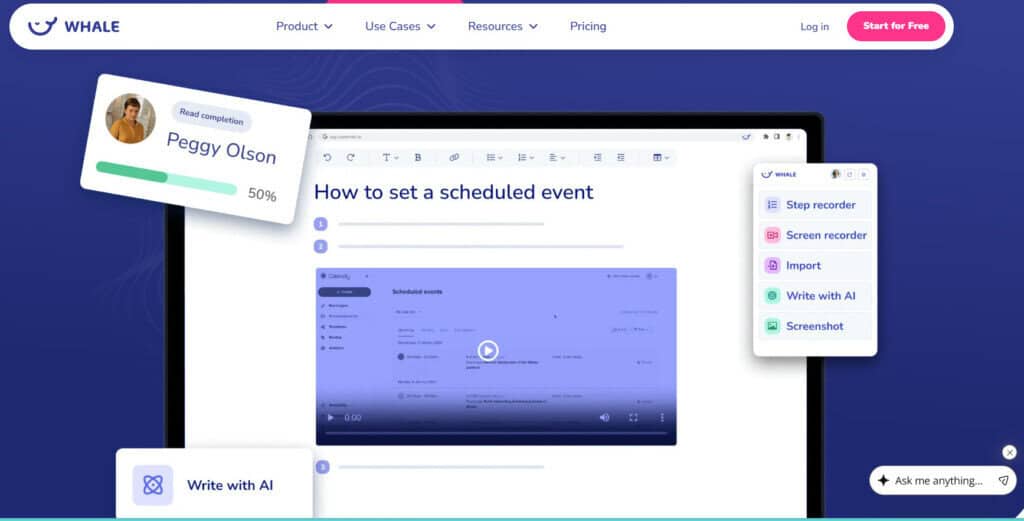
Like Guidde, Whale records your onscreen activity in order to auto-generate guides and tutorials. The difference is that Whale doesn’t output videos; it only provides traditional, text-based SOP documents.
However, it also serves as a knowledge management and training platform designed to centralize SOPs and learning materials. It includes built-in training modules and assignments, allowing you to assess your employees’ grasp of the material they’re covering.
Output Quality
Guidde
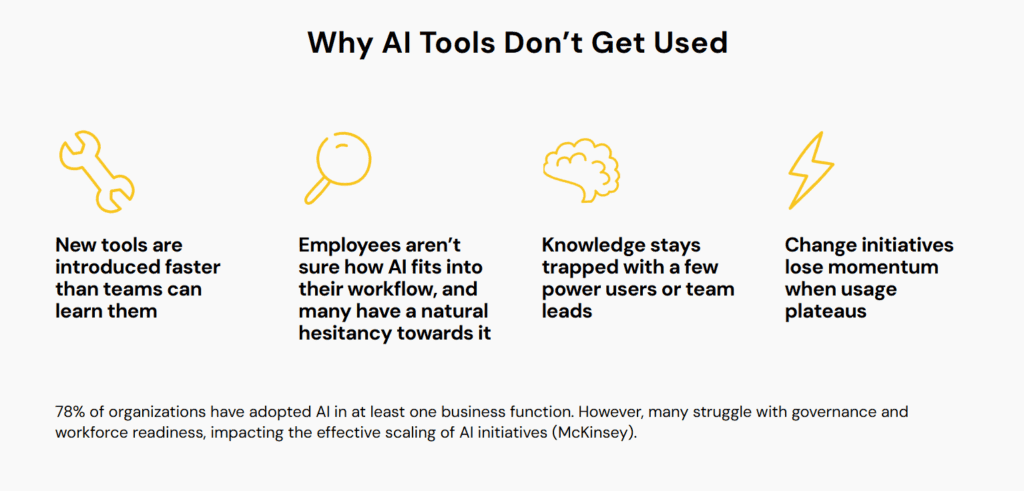
Guidde’s output is its chief selling point. With just a handful of clicks and a browser plugin, you’re automatically generating professionally edited, high-quality how-to videos with text callouts and a clear voice guiding you through each step.
You don’t even have to record any audio yourself; Guidde’s AI automatically generates a voiceover for the video in a natural-sounding voice. For those of you who get shy in front of a mic, this is a big plus.
However, note that since its content is AI-generated, you’ll need to review it carefully to ensure there aren’t any hallucinations or weird-looking visual quirks. Generally, though, its first drafts are pretty impressive.
Whale

Whale’s output is more akin to a structured interactive document or knowledge base article. When you create an SOP in Whale, it ends up as a cleanly formatted page with text instructions, screenshots, and video embeds (if you add any yourself).
This all works relatively well, with a few caveats. Whale’s content editor is a little rigid by 2025 standards; you’re stuck with predefined styles and can’t really customize the look outside of some branding and formatting options. So if you’re expecting to wow viewers with visual flair or dynamic media, Whale might disappoint.
When it comes to documenting internal processes, though, Whale performs just fine.
What’s the Verdict?
Although Whale’s text-and-image guides are effective and accessible, they just can’t compete with Guidde’s videos. Plus, you can always generate text-based tutorials in Guidde as well, especially for highly technical concepts that need to be reviewed several times.
Automations
Guidde

Guidde’s claim to fame is its AI “magic” in creating video guides automatically. After recording your workflow, you just sit back and watch as the app builds a tutorial for you.
Again, no AI tool will give you perfect content right out of the gate, so you’ll have to do a little refinement. However, Guidde’s video generator is as good at executing instructions as any LLM I’ve seen.
It’s also capable of automatically translating your guide into other languages with localized voiceovers and captions, and it offers text-to-speech in different accents — both of which are amazing if you have a global team.
This is automation at its finest, where you’re getting multiple tools (screen recorder, text editor, voice recorder, translation) in one seamless workflow.
Whale
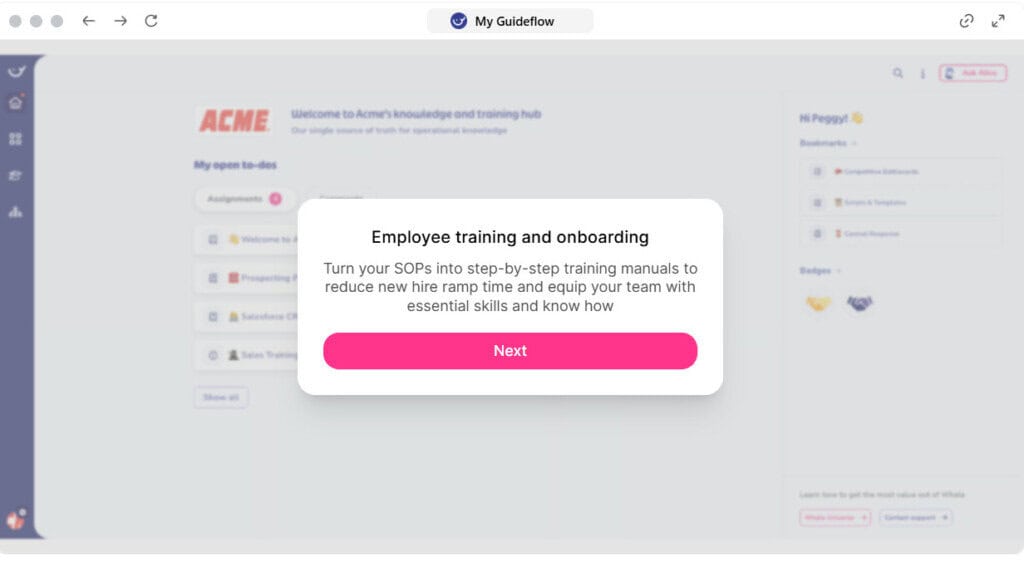
Whale also leverages automation, using an AI-assisted step recorder to capture your clicks, take screenshots while you’re working, and provide suggested text for each step (e.g., “Click on ‘New Invoice’ button”). This definitely accelerates the process of creating written SOPs, but note that the AI is far from perfect, and you’ll need to do quite a bit of editing.
It will also allow you to automate assessment workflows: generating quiz questions from scratch, scheduling training sessions, and sending employees reminders about required assignments. Again, though, there’s still quite a bit of manual work to be done on the content creation side here.
What I really like is Whale’s AI search assistant, Alice, which I found quite handy; employees can type a question in natural language, and the AI will try to direct them to the relevant SOP or give an answer drawn from your documentation.
What’s the Verdict?
Guidde produces more impressive content with less manual involvement, so it’s the clear winner here.
Value
Guidde
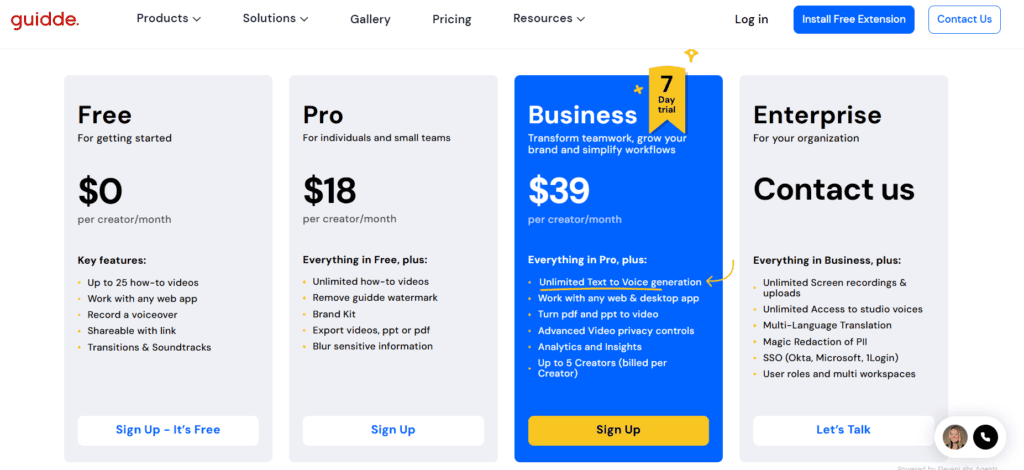
Guidde offers a lot of value at every subscription tier. Even its free tier (which lets you generate 25 videos a month) is really useful, and you might be able to get away with not spending a dime if you don’t have a lot of SOPs and don’t need more advanced features.
But if you need more, Guidde’s Pro plan is $16/creator/month and allows for unlimited videos without watermarks. You also get features like a brand kit, exports to PPT or PDF, and the ability to blur sensitive info in recordings.
On the Business plan ($35/creator/month), you get unlimited text-to-voice generation, desktop app support, the ability to turn PDFs into videos, advanced privacy controls, and an advanced analytics suite.
Importantly, you’re paying per creator here, not per user, so you won’t have to pay extra for every team member who just wants to access content.
Whale
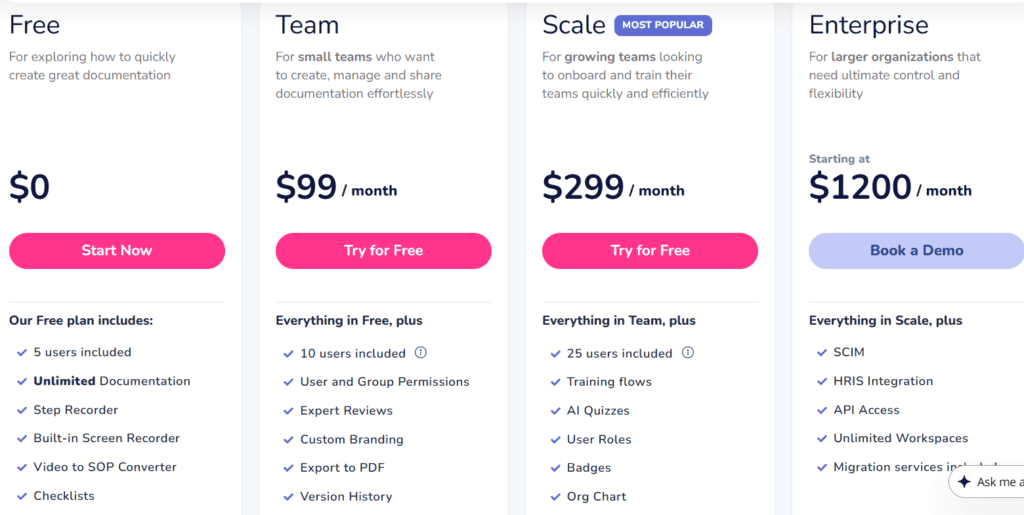
Whale’s free plan allows five users to access an unlimited number of training documents. From here, though, things start getting expensive quickly.
Unlike Guidde, Whale charges you based on the number of team members who can access your tutorials, rather than just those who create them. So if you have a larger team, a subscription won’t get you far.
The Team package will set you back $99 per month, and this only allows access by 10 users.
The Scale tier ($299 per month) is where a lot of companies will land. At this point, you’re getting access for 25 users and most of the platform’s useful features (training flows, AI-generated quizzes, user role management, and an org chart for tracking who has done what).
If you want to make Whale your primary training platform, the $299 could be cheaper than buying a separate LMS. But for SMBs that just need to create and share SOPs, Whale’s pricing means you might be paying for a bunch of extra functionality that you won’t fully use.
What’s the Verdict?
Guidde wins easily here; it offers a lot more for a lot less, and you don’t feel like you have to get the more expensive plan just for core functionalities.
Customer Support
Guidde

Guidde’s team is very hands-on and responsive. If you run into content issues, you can generally reach an agent on the phone pretty quickly. These days, that makes a huge difference when most providers are using AI voice agents.
If you’d prefer not to bother with a call, Guidde also offers an in-app chat and a help center with plenty of useful material.
According to G2 user ratings, Guidde scores a 9.8/10 in Quality of Support.
Whale
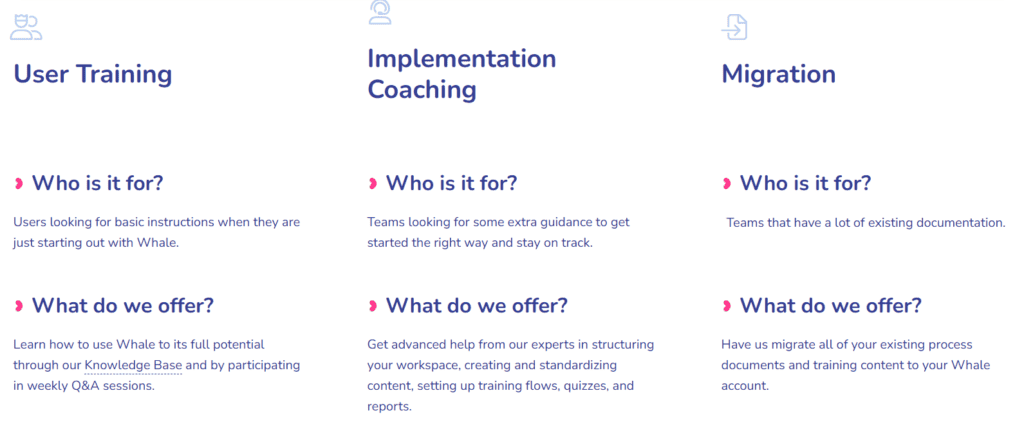
Whale provides support through chat and email. You can expect timely, effective written responses to questions via email at every tier; however, the lack of phone support is unfortunate.
User feedback contains plenty of positive sentiment about Whale’s support infrastructure; like Guidde, it scores a 9.8 score for support on G2.
What’s the Verdict?
Both options take client support seriously, but I’m going with Guidde due to the availability of phone support.
Ease of Use/Setup
Guidde
Guidde definitely has a minimal learning curve, making it very suitable for small teams or solopreneurs who want to get moving quickly.
It feels intuitive from the first click. The interface is clean and modern, and the whole thing is laser-focused on the task of capturing and editing guides — no unnecessary bells and whistles that make some SaaS tools so frustrating to use. And since it primarily operates as a Chrome browser extension (with a web dashboard for editing your videos), installation is literally a one-click add to Chrome.
The editing process is also straightforward and built for non-technical users. If you know how to use basic timeline editing (or even a PowerPoint slideshow), you can handle Guidde’s editor.
Whale
Whale is a more expansive platform, so there’s naturally more to get used to here.
The initial setup involves creating a workspace, adding team members, and organizing content categories. The platform also provides some onboarding checklists and templates for common SOPs, which give a sense of how to structure things.
The interface is clean and modern, with a left sidebar for navigation. If you’ve used any knowledge base software, or even a tool like Confluence or Notion, Whale’s interface will feel familiar enough.
It’s actually very intuitive, given how complex it is, but mastering all of Whale’s capabilities will take a bit of time simply because of how much there is to learn.
What’s the Verdict?
Both tools make things as straightforward as possible, but Guidde is definitely easier to set up and use.
Guidde vs. Whale: Which Is the Winner?
Both Guidde and Whale offer a lot of value for companies looking to streamline their process documentation. However, Guidde is my pick here, and it’s not even close. It’s more powerful, a better value, much easier to use, and its video tutorials blow Whale’s content out of the water. The future of SOPs is here, folks.

